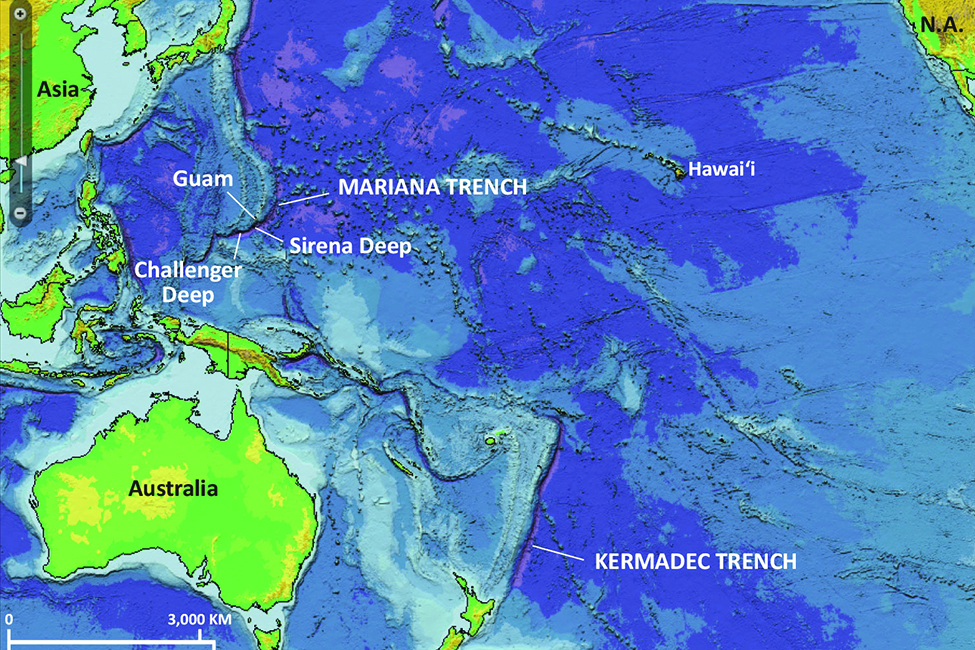FAU Harbor Branch Scientists to Explore Marianas Trench
Two scientists from FAU Harbor Branch will be participating in a NOAA-funded expedition of what's been called the "Grand Canyon" of the ocean.

The Marianas Trench is a crescent-shaped subduction zone where two of the Earth’s tectonic plates collide, creating an ocean trench that is 7 miles at its deepest point.
Scientists with Florida Atlantic University’s Harbor Branch Oceanographic Institute (HBOI) will be lending their expertise during a NOAA-funded expedition to what’s been called the “Grand Canyon” of the ocean - the Pacific Ocean’s Marianas Trench. Deborah Glickson, Ph.D., associate director of the Cooperative Institute for Ocean Exploration, Research and Technology (CIOERT), located at HBOI, will be the geology science lead on Leg 1 from Wednesday, April 20 through Wednesday May 11 of the Marianas Trench Marine National Monument expedition aboard NOAA’s Okeanos Explorer. Shirley Pomponi, Ph.D., executive director of the CIOERT will be the biology science lead on Leg 3 of the scientific cruise from Monday, June 20 through Monday July 11.
The mission, sponsored by NOAA’s Office of Ocean Exploration and Research, is to characterize unknown and poorly explored areas of the Monument by mapping the seafloor and searching for undiscovered biological and geological features such as hydrothermal vents, mud volcanoes, fish and coral reef habitat, and deep-dwelling organisms.
“The Marianas Trench offers such a diversity of habitats,” said Pomponi. “The shallow waters near the islands harbor commercially-important fisheries and ecologically valuable coral reef habitats, while the deeper areas are home to volcanoes with hydrothermal vents and novel deep sea creatures. What is most exciting to us is the potential to discover unknown habitats and organisms in both areas.”
Researchers and students will be following along and participating in the cruise from HBOI’s Exploration Command Center, a facility that allows for real-time access to all of the action via telepresence. High-definition cameras capture video imagery from the ocean floor that is transmitted in real-time via satellite from the ship back to HBOI’s command center, as well as eleven others across the country. Researchers and students can also communicate with the scientists aboard ship via chatrooms and teleconference during the dives.
Located in the western Pacific, east of the Philippines, the Mariana Trench is a crescent-shaped subduction zone where two of the Earth’s tectonic plates collide. At the collision point, one of the plates dives beneath the other, creating an ocean trench that is 7 miles at its deepest point. For more information on the Mariana Trench and the associated U.S. National Monument, visit www.fpir.noaa.gov/MNM/mnm_marianas-trench.html.
The NOAA Office of Ocean Exploration and Research is the only federal organization currently dedicated to exploring our unknown ocean. Their unique capabilities in terms of personnel, technology, infrastructure, exploration missions, and data delivery allow scientists to reduce unknowns in deep-ocean areas and provide the high-value environmental intelligence needed by NOAA and the nation to address both current and emerging science and management needs.
For more information on the expedition, contact Carin Smith at 772-242-2230 or carinsmith@fau.edu, or visit www.fau.edu/hboi.
- FAU -
About Harbor Branch Oceanographic Institute:
Founded in 1971, Harbor Branch Oceanographic Institute at Florida Atlantic University is a research community of marine scientists, engineers, educators and other professionals focused on Ocean Science for a Better World. The institute drives innovation in ocean engineering, at-sea operations, drug discovery and biotechnology from the oceans, coastal ecology and conservation, marine mammal research and conservation, aquaculture, ocean observing systems and marine education. For more information, visit www.fau.edu/hboi.
About Florida Atlantic University:
Florida Atlantic University, established in 1961, officially opened its doors in 1964 as the fifth public university in Florida. Today, the University, with an annual economic impact of $6.3 billion, serves more than 30,000 undergraduate and graduate students at sites throughout its six-county service region in southeast Florida. FAU’s world-class teaching and research faculty serves students through 10 colleges: the Dorothy F. Schmidt College of Arts and Letters, the College of Business, the College for Design and Social Inquiry, the College of Education, the College of Engineering and Computer Science, the Graduate College, the Harriet L. Wilkes Honors College, the Charles E. Schmidt College of Medicine, the Christine E. Lynn College of Nursing and the Charles E. Schmidt College of Science. FAU is ranked as a High Research Activity institution by the Carnegie Foundation for the Advancement of Teaching. The University is placing special focus on the rapid development of critical areas that form the basis of its strategic plan: Healthy aging, biotech, coastal and marine issues, neuroscience, regenerative medicine, informatics, lifespan and the environment. These areas provide opportunities for faculty and students to build upon FAU’s existing strengths in research and scholarship. For more information, visit www.fau.edu.
About NOAA:
NOAA’s mission is to understand and predict changes in the Earth's environment, from the depths of the ocean to the surface of the sun, and to conserve and manage our coastal and marine resources. Join us on Facebook, Twitter, Instagram and our other social media channels.
-FAU-